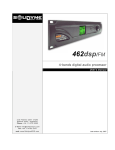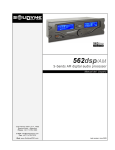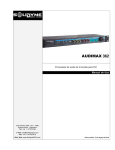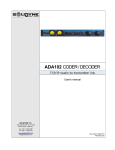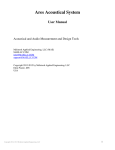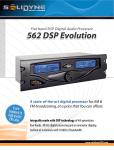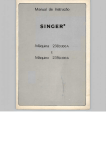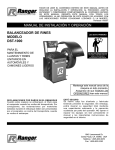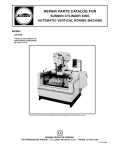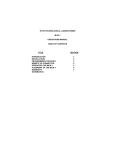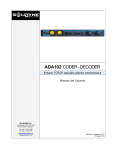Download AUDIMAX 362
Transcript
AUDIMAX 362 3 bands audio processor for FM Users manual 3 de Febrero 3254 (1429) Buenos Aires - Argentina Tel: +54 11 4702 0090 e-mail: [email protected] Fax: +54 11 4702 2375 Web: www.SolidynePRO.com Last revision: 20010 August 10 Pág. 2 AUDIMAX 362 SOLIDYNE Table of contents Chapter 1 – Installation ............................................................................................................................... 5 2.1 2.2 2.3 Generalities ...............................................................................................................................................5 Power source ............................................................................................................................................5 What’s in the box?.....................................................................................................................................5 2.4 Wiring .......................................................................................................................................................5 2.5 2.6 MPX Output ..............................................................................................................................................5 Humming ..................................................................................................................................................5 2.7 2.7.1 Aditional information: Balanced and unbalanced wiring..............................................................................6 Balancead lines........................................................................................................................................6 2.7.2 Unbalanced lines......................................................................................................................................6 2.7.3 2.7.4 Unbalanced output to balanced input........................................................................................................6 Balanced output to unbalanced input ........................................................................................................6 Chapter 2 – Theory of audio processors..................................................................................................... 7 2.1 A brief story... ..........................................................................................................................................7 2.2 Audimax 362 overview .............................................................................................................................8 2.2.1 Introduction..............................................................................................................................................8 2.2.2 Blocks Diagram........................................................................................................................................9 Processing Stages.....................................................................................................................................9 1.2 Stage 1 – Peak Asymmetry Canceller......................................................................................................................9 Stage 2 – Input Expander ........................................................................................................................................9 Stage 3 – Level Input Control ................................................................................................................................10 Stage 4 – Multiband Compressors.........................................................................................................................10 Stage 7 – Stereo Coder .........................................................................................................................................11 MPX processing ....................................................................................................................................................12 Chapter 3 – Operation .............................................................................................................................. 13 3.1 3.2 3.2.1 3.2.2 Starting Up - MPX level...............................................................................................................................13 Audimax MPX output level......................................................................................................................13 Audio settings..........................................................................................................................................13 Input level ..............................................................................................................................................13 Customizing the sound...........................................................................................................................13 Chapter 4 – SC 100 stereo coder calibration............................................................................................ 15 4.1 4.2 4.3 Test points diagram (components side) ...................................................................................................15 Verify Pilot Level......................................................................................................................................15 Pilot Phase adjustment............................................................................................................................16 4.4 Channel Separation .................................................................................................................................16 4.5 4.6 Measurement of Residual Noise ..............................................................................................................17 Audio distortion measurements ...............................................................................................................17 Chapter 5 – Technical Specifications....................................................................................................... 19 SOLIDYNE AUDIMAX 362 Pág. 3 Pág. 4 AUDIMAX 362 SOLIDYNE Chapter 1 – Installation 2.1 What’s in the box? The AudiMax-362 packaging include: 1 Power cord. 1 Guarantee agreement. 4 self-adhesive rubber supports. Generalities the 2 Señal (+) 3 Señal (-) Inputs and outputs are electronically balanced. Inputs come from factory in "bridging" mode, with impedance bigger than 10 Kohms. They must be connected to 600 ohms console’s outputs. For old consoles that only works with real 600 ohms loads at the output, place a 620 ohms resistor inside the XLR input connectors, connected between pins 2 and 3. 1 User’s manual. Please read carefully recommendations: Tierra Conectores de entrada y salida 1 AudiMax-362 Processor (include supports for rack montage). 2.2 1 following • Audimax 362 processors are designed for rack montage in 19” standard racks. Also it can be used on a table or desktop, quitting the lateral supports. 2.5 MPX Output For MPX output use 52 ohms coaxial cable. The connector is a BNC. The maximum length for this cable can be 50 meters. • The room temperature must be between 5 and 40°C (41°/104° F). Avoid the direct solar ray incidence on the equipment. Avoid the proximity of heat sources and high electromagnetic fields (high power transformers, motors, etc). 462-MKII have internal protection against RF fields, that allows assembly it next to AM/FM RF amplifiers. Is very important to have a adequate ground installation. In case of doubt, refers to your Solidyne dealer. • The installation in very humid places or with saline atmosphere will have to be avoided, since they will can cause corrosion in the printed circuit board and electronic component. 2.6 2.3 Power source Verify the correct position of the AC120/220 voltage switch, located on the rear panel. The variation of the AC voltage must be smaller than 10%. Otherwise, use tension stabilizers of fast action. When use the MPX input of the transmitter, make sure that the internal pre-emphasis stage is disabled (flat response between 20 – 100 KHz). Humming If some residual humming appears when the system is started up; turn off the unit. If humming disappears, check the 462 input connections. If the humming still here; unplug the MPX cable. If humming ends, this indicates that a problem occurs with the ground connections. Nevertheless, this problem rarely can occur since the Audimax’s MPX output is differential type, where the BNC connector has floating GND to cancel possible humming. The on/off switch locates on the rear panel. 2.4 Wiring Use shielded twisted pair audio cables of good quality for audio connections (microphone type). Input and output connectors are XLR type (as is standard, female for the inputs and male for the outputs). Connect as the following table indicates: SOLIDYNE AUDIMAX 362 Pág. 5 2.7 2.7.3 ADITIONAL TECHNICAL INFORMATION: Balanced and unbalanced I/O In the following paragraphs you will find information about how to connect unbalanced outs to balanced inputs, and vice versa. This information will be of extreme utility, not only for Audimax 362, but also for other equipment of your radio. Different cases are decrypted. In order to connect an unbalanced output to a balanced input, you need to unbalance the input. This is obtained sending to GND the negative (-) terminal on the balanced input connector, and connecting the other one to the signal cable of unbalanced source. The ground of the input must be connected to the output’s ground (shield of the cable). • 2.7.1 Balancead lines Balanced lines use three cables to transmit the signal: positive, negative and ground. The negative takes the same audio signal of that the positive but inverted 180°. GND corresponds to the shield of the cable, which rejects the electrostatic noise (switches, big motors, etc.). The fact that the audio signal is sent by two cables, inverted in one of them, practically annuls the noise induced on the cable, specially the electromagnetic one, caused by fluorescent tubes, AC lines, etc. A balanced input amplifies only the difference between both positive and negative signal. Since the induced noise causes the same deviation in both cables, when reducing both signals the noise is eliminated (the (-) wire invert its phase, then, the induced noise is reduced to itself). In addition, equipments that uses balanced I/O are of professional category and uses line levels of +4dBu (1,23 Volts). Connectors are XLR or stereo plugs (one by channel). 2.7.2 Unbalanced output to balanced input If the input is a stereo jack, the adaptation can be made using a mono plug connected in the following way: the shield to the sleeve and the live to the tip. The sleeve of the mono plug will send the negative terminal of balanced input (jack’s ring) to GND. • If the input is of XLR type, the shield of the unbalanced cable must be connected to pins 1 and 3 and the live to pin 2. 2.7.4 Balanced output to unbalanced input For this case, leave unconnected the negative (-) wire of the balanced output, joining the positive to the unbalanced input. Unbalanced lines They are used in “home” and non-professional equipment. The audio is sent by a pair of cables; being the one alive and other the shield of the cable. These cables are much more sensible to the noise, mainly of electromagnetic type. They handle line levels of the order of -10dBv (0.36 Volts). • If the balanced output have a stereo jack connector and you need to connect it to an input with mono jack (unbalanced), you can use a stereo plug-plug cable, but disconnecting the ring on the input plug. The connection is made using the tip (signal) and sleeve (GND). • If the output is XLR type, leave unconnected the pin 3, and connect the live to pin 2 and the shield to pin 1. The other ends of the cable will have RCA or mono plug connector. • If the unbalanced input is stereo, and uses an stereo jack, you need to make an special cable, in which the plug’s tip is connected to left channel and the ring to the right channel, in both cases unbalanced as was explained. The connectors typically used on this kind of units are RCA o male plugs (TRS). Pág. 6 AUDIMAX 362 SOLIDYNE Chapter 2 – Theory of audio processors NOTE: in order to complement the study of this subject is recommended to visit our WEB (www.solidynepro.com). In the DEMO section there are a Power Point presentation called Audio Processors. It has a complete Technical Appendix that it analyzes how the audio processing increases the coverage area of the FM stereo transmission. . 2.1 A brief story... From mid of the 1930 decade, when appears the first compressors and expanders units, to the present time, all chains of audio for broadcasting incorporate devices whose function is to alter the dynamic range of the sound. The advance of the technology improves these devices during the ‘70s. The compressors, expanders and audio limiters were gaining in efficiency and complexity. In the beginning, its main parameters (attack and recovery times, thresholds, etc.) were fixed by design or by the operator, through the device’s controls. In the '70s, these functions begin to be automatic, based on the characteristics of the audio signal, but having at the same time a control on their action to be able to customize the sound. When five or more devices are grouped in a same equipment, they begin to be denominated: AUDIO PROCESSORS. Since 1970, Solidyne introduces important advances in this field, like the invention of a control technique based on FET’s with guided gate (see publication in Rev. Tel. Electrónica, September/70). They follow diverse publications, having particular international relevance the work published in June/76 at the Journal of the Audio Engineering Society, New York, U.S.A. where a new concept was introduced, which persist to the present time: PHSICOACUSTIC PROCESSING. This new technique is the base for all the modern audio processors for broadcasting use. The necessity to process the phase to make symmetrical the human voice waveform is another one of the techniques that Solidyne has introduced internationally (see mentioned article AES). Today, Orban, Omnia, Aphex, etc use our ideas. The concept of psychoacoustic processing is simple in essence, although of complex accomplishment. It consists of analyzing the way in which the sound is perceived by our ear, considering diverse investigations and developed acoustic models. SOLIDYNE AUDIMAX 362 The brain uses to process audio data, the information that arrives through 30,000 nervous fibers, originating at the Basilar membrane. Then, it will be possible to be computed the auditory reactions and to be governed all the aspects of the audio processing. This way, the electronic system works transforming the original signal into another one, of greater energy and greater quality of sound. Then, it will be possible to reduce the dynamic range of the audio signals, to eliminate the peaks, and even, to clip them partially to increase its energy. If this were made directly, obeying to purely electronic concepts of efficiency, the quality would be degraded and the sound would be very poor. If, however, the psycho acoustic concepts are applied, and factors like the aural masking, the pre and post pulse inhibitions, the Hass effect, the reflections at the ear pinna, the aural models of Dr Karjalainen, etc; it will be possible to create a new generation of processors that allow to important increases of energy, increasing at the same time the sensation of “Perceived Sound Quality”. At the light of these discoveries the psychoacoustics processing was defined in these terms: PHSYCO ACO ÚST I C PRO CESSI NG i s t h e t e c h n i q u e t h a t a l l o ws t o i n c r e a s e t h e r a n g e o f AM o r s t e r e o F M t r a n s m i s s i o n , by increasing the energy of the audio signal, and also increasing the “quality of sound” perceived by the listener. Nevertheless, it is fundamental throughout this process, to maintain very low the audio distortion produced by harmonic and IM components. This happens because the psychoacoustic processing MODIFIES the waveform of the complex signal of audio, but IT DOES NOT DISTORT IT. Since the distortion concept, in this context, implies the existence of a sound that offends the ear, sounding unnatural. Pág. 7 This is because the psychoacoustic processing obtains that the ear accepts like of better quality than the original one, to certain modifications of the waveform. But it does not mean an "anesthesia" to the ear, to avoid perceiving the distortions due to deficiencies in the quality of the electronic circuits of the processors. Considering that to obtain an excellent processing is necessary, at the moment, to use between 7 and 10 stages of processors, the distortion of each stage must be smaller than 0.01%. Greater distortion values, will lead inexorably to a degradation of the sound quality. You must remember that has been demonstrated (Journal of AES, Vol. 29,4,p.243), that is possible to measure distortions of 0.05% through a common loudspeaker (distortion bigger than 3%). This demonstrates that one distortion do not mask another one. A practical rule is, then: ALL DISTORTION INTRODUCED IN THE AUDIO CHAIN OF THE TRANSMITTER, THAT EXCEEDS 0.05%, COULD BE LISTENED BY THE AUDIENCE, EVEN THROUGH RECEIVERS THAT HAVE VALUES OF DISTORSION 50 TIMES GREATER. This, of course, is not a novelty for the conscious audio engineers around the World. Therefore, the line of SOLIDYNE processors has distortion values smaller than 0,02%. Few controls, easy adjustment, inviolable... The psychoacoustic processors created by Solidyne, have 70% of their functions automatically fit, under the control of the audio program. But they also present the essential controls for customize the sound of the radio, that you can adjust. 2.2 Audimax 362 overview 2.2.1 Introduction The Audimax 362 has 7 processing stages and the stereo coder. Its main characteristic is the ease of use, because it doesn’t require a specialized technician to start up and to adjust the unit; and neither it has the critical “Input level” control, since an automatic system adapts the input gain to the output level of any audio console, avoiding the more frequent operational errors. His low cost is appropriate for low-power FM radios, as well for recording studio of high power radio stations. The 362-IT model is an excellent processor for WEBcasting (radio on Internet). Operating in a FM radio, the AudiMax 362 increases the reach of the transmission, improving the covered area between 30 and 50%, obtaining an impressive audio quality that will distinguish your radio station. The AudiMax sound is smooth and warmth, with the classic characteristics of the analogical processes of high technology. AudiMax 362 works with 3 bands and it’s controlled totally by VCA (Voltage Controlled Amplifiers). The stereo coder stage uses digital synthesis with 16X oversampling, a technology developed by Solidyne that guarantees ultra-low distortion and high channel’s separation, not requiring any readjustment during all its life utility. MPX output is differential type, cancelling the residual humming. AudiMax 362 has a great advantage: it does not have critical adjustments. This means that in any position of his controls always it sounds well. The adjustment can be made then by inexpert people. Simply taking all the controls to the center position, you have an excellent sound on the air. From there customize the sound so that the radio sounds as you desired (this it is a question of personal taste). Pág. 8 AUDIMAX 362 SOLIDYNE 2.2.2 Blocks Diagram 1.2 Processing Stages the work of Oscar Bonello, published at the Journal of AES, Vol.24,5 in which it is described, for the first time, the theory of its operation. Stage 1 – Peak Asymmetry Canceller It is known that, by a particularity disposition of the vocal cords, the sonorous emission that these generate are asymmetric triangular pulses. The three cavities that filter and shape these formants, to obtain the vocal sounds, do not modify this intrinsic characteristic of the human voice. All the spoken word and still sung is strongly asymmetric. This creates an important reduction of the energy of the audio signal, particularly when it pass through a compressor, because the compressor sets its compression level for the greater peak, does not concern its polarity. In this way, when a polarity is fit to the 100%, the opposite polarity hardly surpasses 50%, due to the asymmetry. The fact that the music sounds louder than the human voice, after pass through a compressor is a phenomenon well known. This is because the musical sounds are symmetrical, whereas the human voice is not. In order to correct this problem, WITHOUT INTRODUCING ANY ALTERATION AT THE SOUND QUALITY, peak asymmetry canceller is used. This technique, based in a discovery of the Dr Leonard Kahn, acquires international validity with SOLIDYNE AUDIMAX 362 The peak asymmetry canceller is in essence an all-pass network, a class of not minimum phase network. That is: a network whose transference function has zeros in the right semi plane. This network has a full flat response to frequency; only its phase response is function of the frequency. This phase rotation, which must compliment very particular conditions, is responsible of the peak symmetry of the audio signals. Signals that by their nature are symmetrical (like most of the musical instruments), are not modified by this processor. This processor, by itself, allows to increase between 3 and 5 dB the final power broadcast by your transmitter (it is to say that it increases by a factor of TWO the average power transmitted). Numerous tests have been made in different countries, to verify, in real conditions, these results. Stage 2 – Input Expander The expander, previous to the compression process, is an excellent resource to increase the signal/noise ratio of the original program. This is advisable, since the compression process, when Pág. 9 reducing the high level passages, consequently increases the relative level of the passages of low level, and therefore the noise. This is a forced consequence of the compression process that has particular effect in the increasing of the ambient noise of the microphones. In order to avoid that, the Solidyne processors incorporate a linear expander, previous to the compressor stage. The concept of linear expander implies an expander that works within a very wide range of signals, below a threshold value. That means it always expands within that range, for any level of signal. That is to say that their curve of transference, based on the input level, is a straight line (from there the "linear" name). This implies that by each 10 dB that the input level reduces, the expander will reduce, for example, 13 dB. This happens for any input value, below the threshold. Then if the input is reduced in 30 dB, the output will do it in 39 dB; that is to say that the background noise has been reduced in 9 dB. This way, the expander compensates the increase of the noise that the compressor, like undesired effect, will increase. At this point, maybe you will be thinking that DOES NOT HAVE SENSE to make an expander of the signal and soon to compress it. You will think, perhaps, that an effect cancels to the other. But it’s not true for two reasons. First: the different attack and recovery times. Second: multiband compressors have elevated threshold, whereas the linear expander has a very low threshold and a linear behavior below the threshold. It means that the actions do not cancel, because both processes are not complementary. The linear expander, to optimize its behavior, has instantaneous attack and a fast recovery times. Here is where the psychoacoustic concept “postpulse hearing inhibition” is used. This allows using an expander with a quick recovery time, so that the ear does not perceive it. The broadband compressor that follows the expander has a very slow recovery time. Therefore, with impulsive signals, as the audio program, does not exist any cancellation effect. Another advantage of using a linear expander previous to the processing is that an excellent audible sensation of dynamic range is obtained. In fact, recent studies have demonstrated that the audible sensation produced by the level variations of an audio signal, is related to the changes happened in the first 50 milliseconds, and is little dependent of the reached final value. This implies that an expander in the short term is perceived like a great dynamic range, whereas the power sensation (and even the coverage area Pág. 10 of the radio transmitter) is related to the AVERAGE ENERGY, which depends of the compression of the energy level. You can see that they are two concepts different. With audio processors of conventional design, the expander and the compression were antagonistic concepts. This does not happen in the field of the psychoacoustics processors. Stage 3 – Level Input Control The Audimax-362 has an automatic control for the input gain. Manual adjustments are not necessary. The AGC (Automatic Gain Control) guarantee that the audio signal enters to the delicate multiband compressors always with the same level, avoiding variations on the transmitted signal. The AGC is designed to work with input levels from –10 dBu to +15 dBu, which qualifies to the AudiMax to work with all types of audio consoles, from DJ’s mixers to professional broadcasting consoles! Stage 4 – Multiband Compressors The purpose of the multiband compressors is to increase the perceived loudness sensation. The human voice and music will sound more solid, with better dynamic balance. Still more, the increase of the average energy of the audio signal is very considerable, increasing the coverage area of the radio for A.M. and FM transmissions (for more info visit www.solidynepro.com). Multiband technology bases on the studies of Stevens (ref 1.2.3) about the loudness of each band frequency and the studies of Zwicker (ref 4) about its relation with the Critics Bands of the human ear. The integration time of the ear to reach the maximum loudness is of the order of 200 milliseconds (ref 5). This time must carefully be incorporated to the controls of the loudness compressors, to obtain the desired effect. The ear will perceive a greater loudness when the band compressors increase the relative loudness level. The processor Orion 462 has frequency splitters with Butterworth filters of 18 dB/octave that divides the program signal in four frequency bands: low, low-middle, high-middle, high. In this form, the multiband compressor in independent form processes each bank of frequencies. This way is possible: 1. To increase the total energy, by the use of fast compressors for bass and ultra-fast for treble. If AUDIMAX 362 SOLIDYNE the bands were not divided, the compressors with so fast recovery time would produce a disagreeable sound effect; the percussion of low frequencies would modulate the high notes. And the high notes of an instrument would as well modulate the low tones, of violoncello, for example. 2. To increase the perceived loudness. This is because most of the modulation capacity of a transmitter is generally devoted to low frequency signals, of less than 160 Hertz. Nevertheless this information contributes very little to the loudness sensation, due to the reduced sensitivity of the ear for those frequencies. Therefore is desirable to increase the level of the medium and high frequencies. But this cannot be obtained by simple equalizing, because the sound balance would be destroyed. On the other hand, the peaks of high frequency would saturate the transmitter. The compression in separated bands allows increasing between 6 and 12 dB the energy for high frequencies without altering the tone balance; in fact, the frequency response continues being totally flat. 3. To improve the audio quality. Processing completely eliminate the "flat sound" sensation, perceived when a sonorous material is compressed, by means of fast compressors. This is obtained, additionally to the division in bands, using attack times appreciably elevated. This allows that very short peaks of the audio signal arrive freely to the following processor (peak clipper), that eliminates them, but maintaining the psychoacoustic sensation of power associated with the audio peaks. Stage 5 – Dynamic Equalizer The Dynamic EQ is a 3 bands audio equalizer that acts over the threshold of the multiband compressor. This technology operates in 3 bands (low, middle and high) modifying the density of energy (instead the level) of each band. Is formed by complementary filters of 18dB/octave carefully designed to obtain flat response. This built-in equalizer offers an enormous flexibility. In example: is well-known that the use of EQ at the console output has an adverse effect in the sound quality, since the more a frequency band is emphasized, grater is the action of the audio compressor (previous to the transmitter) for that band. Equalize a band implies to unbalance the SOLIDYNE AUDIMAX 362 entire audio spectrum. It doesn’t happen with DENSITY EQ, since its action is coordinated with the following stages. The boosting of a frequency band is translated then in a correlative modification of the multiband compressor threshold, to carry out the new equalization. In this form, its action extends to the range of sounds of very high intensity, where the conventional EQ’s are inefficient, due the excessive compression. Stage 6 – Energy Bands Band Energy controls increase the peak density of the audio bands, obtaining signals with very high loudness. Knobs act on the recovery times of the compressors. Each band have a different recovery time, of variable range. "Energy Bands" adjusts according to the music’s style that the radio manages. Turning the controls to the left you will have a smooth sound (long recovery times); whereas turning them to the right you increases the energy for the bands, which will produce a more “hard" sound with great "punch" and "sharp" highs (fast recovery times). As example we say that for melodic music, classic (academic), etc., in which there is no noticeable rhythmical support, agrees not to emphasize too much the Energy Band controls, that is to say, to use long recovery times. For Rock & Pop is advisable to increase the energy bands so that the sound has more "punch". Stage 7 – Stereo Coder The sum of the signals is sent to the stereo coder. It uses digital technology to generate the MPX signal. This technique, created by Solidyne, allows to obtain a perfect coder with distortion 10 times below the audibility threshold and channel separation better than 75 dB. It’s based on the oversampling concept, that divides the audio signal in 16 samples that are processed separately at 38 x 16 = 608 KHz. Due to this elevated sampling rate, the anti-alias filters works over 500 KHz, eliminating the “phase rotation” effect at 53 KHz. With this new solution and the use of advanced technology in each part of the circuit, residual components of distortion below -90 dB are obtained. It is described separately in this manual, the way to do measurements and reception tests of the stereo coder (see Chapter 4). Pág. 11 MPX processing The studies about the modulation on an FM transmitter indicate that when the transmitter is modulated by stereo MPX signal appears a new effect, not present on the original audio signal. This effect, denominated in U.S.A. MPX Interleaving (also known as peak correlation), determines that the modulation peak in MPX does not coincide with the modulation peak of the stereo signal, considered in independent form. 7.Oscar Bonello PC CONTROLLED PSYCHOACOUSTIC AUDIO PROCESSOR, 94th Audio Convention, Berlin March 1993 8.- Oscar Bonello, Burst Masking (Enmascaramiento por Ráfaga) Anales del II Congreso Iberoamericano de Acústica, Madrid, octubre 2000 9.- Oscar Bonello, Multiband Audio Processing and Its Influence on the Coverage Area of FM Stereo Transmission, Journal of Audio Engineering Society, New York, March 2007 This means, in simple terms, that if the peaks of channels L and R are limited separately so that MPX signal never over modulate, during most of the time, the modulation capacity of the transmitter will be wasted. And this happens because signal MPX is the sum of L+R but also includes the 38 KHz sub-carrier. According to the relation of phase between these three elements, there will be different peak values for the interleaving. This phenomenon indicates that is possible to increase the modulation without increasing the deviation of 75 KHz of the transmission, taking advantage of the modulation capacity that normally is wasted. Audimax 362 processor uses a MPX Processing technology named Super Modulation. This processing consists on a system that controls the peaks, operating at 608 Khz, eliminating the peaks in MPX base band signal and filtering them so that there are not left residual components. REFERENCES 1.- S. S. Stevens, The measurement of loudness, ASA Journal, Vol.27, pg. 815. 2.- S. S. Stevens, The direct estimations of sensory magnitudes-loudness; American J. Psychol. 69, 1-25, 1956. 3.- S. S. Stevens, Concerning the form of the loudness function; ASA Journal, Vol. 29, pg 603-606, 1957. 4.- E. Zwicker – Flottrop – Stevens; critical bandwidth in loudness sumation, ASA Journal, Vol. 29, pg. 548557, 1957. 5.- Stanley Gelfand, Hearing, pg. 392, Edited by M. Dekker, N. York, 1990. 6.- Oscar Bonello . NEW IMPROVEMENTS IN AUDIO SIGNAL PROCESSING Journal of the Audio Engineering Society, Vol. 24 Nº 5. USA, 1976 Pág. 12 AUDIMAX 362 SOLIDYNE Chapter 3 – Operation 3.1 Starting Up - MPX level The first adjustment is the modulation level on the transmitter. For this, places all 362’s knobs to the center position. Play on the air sung musical themes. The console level will have to arrive at the red zone of the VU-meters in the signal peaks. Measure the level of modulation of the FM exciter with a good monitor of modulation (like Solidyne VA16) or use the modulation meter of you FM exciter. Adjust the MPX input level of the FM exciter until obtaining a modulation of 100% an the peaks. In some countries (norms FCC for USA) not frequent recurrence peaks of 110% are allowed. Audimax MPX output level (only for units with serial number bigger than 1200). Audimax 362 comes with a MPX gain control. On the rear panel, you will find a preset that allows you to adjust the MPX output level, using a screwdriver. This avoids the use of the exciter input level. 3.2 Audio settings Audimax 362 was designed to offers an easy and very intuitive operation. You don’t need to have specialized knowledge to start up the processor and to adjust the sound settings. Simply begins placing all knobs to the center position. That is all! You will be on-air with a great sound. Soon you will have to customise the sound according to the musical style of your radio, for which we recommends you to read the following explanations kindly. 3.2.1 Input level Audimax 362 has an automated control for the input level. You can connect from nonprofessional consoles, with output level of -10 dBv, to professional broadcast consoles with +8dBm output level. The AudiMax input level will adjust automatically. The automated input level control eliminates variations of level due to badly use of the air console on the part of the DJ’s or inexperienced operators. That is to say: if the level from the console stays very low by several minutes, Audimax will compensate its input to maintain uniform the output level. SOLIDYNE AUDIMAX 362 3.2.2 Customizing the sound All adjustments are made from seven knobs located in the front panel. Dynamic Equalizer section is a 3-bands dynamic audio equalizer that allows reinforcing certain frequencies, generally the bass, to have a sound with ‘punch’ basses, ideal for the car-stereos. Unlike the conventional EQ’s, whose action is lost for high levels of modulation, this EQ emphasizes its action when higher is the modulation. To adjust the dynamic EQ, make sure that the multiband compressor is operating. For this, see the LED’s meters located at the right; the yellow LED’s must be illuminated; being able to blink the greens. In these conditions, turns the Dynamic Equalizer knobs (low, mid and hi). Turning the knobs to the left, the response of the dynamic EQ will be flat. Turning the knobs to the right, a boost in this band takes place. When you boost a band, the action of the compressor for this band increases. The Band Energy section increases the peaks density for the band, achieving high loudness signals. This control changes the recovery times of the audio compressors. It must be settled according to the musical style and the kind of sound that you’re looking for your radio: compact with high loudness and “punch'’, turning the knobs to the right (fast recovery times); or more soft and smoothly, with the knobs at the left (slow recovery times). Multiband Compressor is the core of the processing system, constituted by 3 independent audio compressors that works on 3 frequency bands: Low, Mid and Highs. Pág. 13 The Multiband control changes the input gain of the compressors. This control affects more radically the output level of the Audimax 362. Turning this knob to the left you will obtain a smoother sound, with little processing and therefore with less energy. Turning it to the right, you will increase the processing and the energy of the sound. Take in mind that with an excessive processing you will obtain a very hard sound on the air, with high energy, but too compressed (smaller dynamic range) and with less definition (more clipping). Normally an suitable level is obtained when the indicators LED’s of the multiband compressor act without light the red LED. Very important: In order to the Dynamic EQ and Band Energy take effect, is necessary that the multiband compressor works. That is to say, in all bands the first LED must be lights, and still better, the second too. If the compressors don’t works, the others controls don’t take effect on the sound, since they are linked to the multiband compressor. Pág. 14 AUDIMAX 362 SOLIDYNE Chapter 4 – SC 100 stereo coder calibration Normally the stereo coder doesn’t need calibration because it’s a full stable (after many years) design based on digital oversampling 16x technology. If you wish to make a control or fine-tuning please follow the following steps. PLEASE! IF YOU DON’T HAVE A GOOD KNOWLEDGE OF THE MATRIX STEREO THEORY OR DON’T HAVE THE APPROPRIATE MEASUREMENT SET, DO NOT INTEND TO CALIBRATE THE STEREO CODER. 4.1 Test points diagram (components side) 4.2 Verify Pilot Level a) Connect to ground the test point TP1 in order to eliminate the 19 KHz pilot tone. Use a good DC-20 Mhz calibrated oscilloscope at the MPX output connector. Connect a sine wave generator at the LEFT input of the audio processor, at 1 Khz, + 4 dBm output. Verify that the output waveform looks like FIG-1. Set the output level preset to maximum (4 Vpp). SOLIDYNE AUDIMAX 362 Pág. 15 b) Replace the audio generator at the processors Left input for audio program (music or voice). Please carefully take note of this peak-to-peak value; let name it Xpp. c) Disconnect the audio program from the LEFT input and disconnect the ground of the test point TP1. Then, the 19 Khz pilot tone will appear. d) With the oscilloscope measure the peak-topeak value of the 19 Khz pilot tone; let name it Ppp. FIG.2 Pilot Phase 10X The percentage level of pilot tone will be: Calibrate the P10 Phase Control to get zero phase error. The phase error is indicated by the tilt of the imaginary line between H1-H2 points. When this line is full horizontal, the phase is correct. Pilot Level [%] = 100.Ppp / Xpp e) This value must be between 9 to 11 % Otherwise, please contact your Solidyne dealer. NOTE: If you have a Solidyne VA16 modulation monitor or BELAR FMS-2 measurement set, you will be able to measure pilot tone level from on-air transmission. 4.3 Pilot Phase adjustment This method is an absolute system not dependent from the calibration of the Modulation Monitor. You will need a very good DC-20 Mhz oscilloscope (Tektronix preferred) with vertical 10x undistorted span. Proceed: a) Change the PHASE jumper (JF1) from the Normal “N” position to calibrate “C” position. b) Input a sine wave generator at 1 KHz, +4 dBm, at Left Channel of the audio processor. Adjust the level of wave generator to get 4 Vpp MPX output. c) Connect the oscilloscope to the MPX output in mode DC. Use the sine wave output of audio generator, to synchronize the oscilloscope sweep. Adjust the sweep to 5 uS/Div. Modify with trigger level, the center of the wave in order to have it centered at screen. e) Change the phase calibration jumper to NORMAL mode ( “N” position). 4.4 Channel Separation Since the stereo coder uses a digital technology, there is not any kind of adjustments controls for stereo separation. A good measurement set like the BELAR (USA) model FMS-2, will be needed. If you do not have an excellent measurement set, please do not intend this measure. Note : This measure must be done with stereo coder inputs disconnected from audio processor. Then the jumpers JL & JR must be open. a) Connect the BELAR measurement set to the MPX output connector. b) Check the PHASE mode of the Belar. You must get at least – 65 dB rejection of 19 KHz pilot tone. If not, please make the Belar calibration procedure of PHASE (see Belar manual) c) Connect a sine wave generator at 400 Hz, 1V RMS to the Left Input (JL). Leave disconnected the right input JR. Adjust vertical sensitivity to 50 mV/Div. You must get a signal like FIG-2. d) Measure channel separation at the Belar. Right channel. It will be better than 60 dB If not, you must do a slight change in the frequency knob of the audio generator in order to avoid integral multiplication factors that do not allow you to appreciate the correct image. e) Now, connect the sine wave generator, at the same frequency and level, to the Right Channel (pin JR). Pág. 16 AUDIMAX 362 SOLIDYNE f) Measure at the Belar the residual level of the Left channel. It will be better than 60 dB. g) Verify channel separation at the 20 Hz – 12.000 Hz range. This must be better than 50 dB (60 dB typical). 4.5 H1 = Level of fundamental tone. Hn = Level of harmonics (reduced by the gain set of the THD meter). Verify that the distortion level is fewer than 0,003 % at 1 KHz. Measurement of Residual Noise Open the jumpers JL & JR. Use a good Audio Voltmeter with A weighted filter connected at the Left and Right audio outputs of the BELAR modulation monitor. Use as reference 4 Vpp sine wave. Values better than 92 dBA must be measured (94 dBA is typical value) 4.6 Audio distortion measurements Connect a good distortion measurement set like System ONE or Sound Tech ST 1710A to the Left & Right audio outputs of the BELAR set. Values under 0,01 % must be measured at 1 kHz Since Belar has it distortion floor at 0,01%, in order to measure the real distortion of 362 stereo coder, is recommended to use a procedure not based on modulation monitors. Proceed this way: a) Connect to ground Test Point TP1 in order to cancel 19 KHz Pilot b) Then, connect a very low distortion audio generator at both inputs JL & JR. This will cancel 38 Khz subcarrier. Connect a good THD distortion measurement set at the MPX output of stereo coder. Adjust to minimum value the THD meter. c) Use the monitor output of the THD measurement set to analyze the distortion products in order to separate 38 KHz residual and noise from the distortion components. Use a Tektronix 5L4 N analyzer, or TiePie FFT HS3 probe, or SoundTech Lab software, etc. Identify the harmonics of 1 KHz and calculate: Distorsión = SOLIDYNE 100 × H 22 + H 32 + H 4 2 + Κ H1 ( ) 1 2 AUDIMAX 362 Pág. 17 SOLIDYNE AUDIMAX 362 Pág. 18 Chapter 5 – Technical Specifications Input XLR3 connector, self-adjusted level Level: -10 dBu to + 15 dBu Z= 600 / 10 Kohms, balanced Power 115 V / 230 V (rear switch selected) 50/60 Hz, 20 W Dimensions Output Balanced, + 4 dBu Z= 600 / 10 Kohms, with de-emphasis 19" rack mount. Module one (44,4 mm) Pilot tone stability +/- 0,002 % (+/- 0,5 Hz) MPX Output 600/10 Kohms, factory set level to standard 4 Vpp Differential output to cancel hum loops between transmitter and studio ground Stereo Coder Specifications Measured from internal Stereo coder jumper to MPX out Audio input 2 Vpp for 100 % MPX output (4 Vpp) Frequency Response 20 - 16.000 Hz +/- 0,5 dB measured below compression & limiter threshold Frequency Response 15 Khz/5 order elliptic LP filter 20-15.000 +/- 1 dB Attenuation at 19 Khz > 50 dB Harmonic Distortion Below 0,02 % @ 30-15.000 Hz Harmonic Distortion Less than 0,01 % THD at 1 Khz Below 0,015 % 20-10.000 Hz Noise Below - 90 dBA ref 100 % modulation Signal to Noise Ratio Better than 85 dBA with reference to 100% modulation Stereo Separation > 75 dBA Subsonic Filter Chebyshev 2nd order, 15 Hz Asymmetry Cancelling 5 : 1 cancelling effect, using Khann-Bonello method Stereo Separation Better than 50 dB @ 20-10.000 Hz Typical > 60 dB at 1 Khz 38, 57, 76 & 95 KHz suppression Below - 70 dB Expander 10:1 slope, 100 uS attack time AGC (wideband) VCA controlled, 30 dB range Multiband Compressors 3 bands, 18 dB/octave, Linear Phase crossover Compressors: 30 dB full range, 5:1 slope Automatic attack time / Release controlled by Energy panel controls IM Cancelled Clipper IM attenuation > 30 dB below 250 Hz Dynamic EQ 0 - 12 dB dynamic boost at Low, Mid and High Frequency Processing Power 7 stages of processing devices SOLIDYNE AUDIMAX 362 Pág. 19



















